Note: This post is a part of the series of posts about best chess books divided by openings. If you are wondering how I select the books I recommend, or what other openings I have covered at the moment, I refer you to the reference post of the entire series.
Note 2: If you are interested in the basics of the French defence, you might want to check the following post, aptly titled „What every chess player should know about the French Defence?“
Table of Contents
INTRODUCTION
Even though the French defence has never enjoyed the same reputation as the open games with 1… e5 or the Sicilian with 1… c5, it has always been regarded as a worthy reply to 1 e4.
Throughout the history, it has been championed by several World Champions like Alexander Alekhine, Mikhail Botvinnik or Tigran Petrosian, but there were also some non-World Champion experts like Wolfgang Uhlmann or the best player never to become World Champion, Viktor Korchnoi. It is also frequently seen on the club level where several Black players play it almost exclusively.
However, due to the rugged and manoeuvring nature of play, it is a very challenging and difficult opening to play. Players with both colours often have problems understanding it completely and handling it in the most precise manner. 1
Fortunately, due to its popularity and the fact many prominent players employ it on a regular basis, there is an abundance of literature devoted to this opening. Black players are especially spoilt for choice because in recent years several renowned grandmasters (Vitiugov, Aagard) wrote a number of top-notch books recommending plans and ideas for Black.
However, White players also shouldn’t complain too much as I have been able to dig several books recommending different variations to deal with this opening that causes us all a lot of headache.
Therefore, without further ado, let’s check the list of best books about the French defence. I will cover books from the White perspective first and then switch to books from the Black perspective.
FRENCH DEFENCE FROM THE WHITE PERSPECTIVE
Keep it Simple: 1. e4: A Solid and Straightforward Chess Opening Repertoire for White by Christof Sielecki
Recommended line(s)
Exchange Variation with 3. exd5, followed by c4
Recommended level
Beginner, Intermediate
Brief overview
I will begin this list with a book that wasn’t intended to become a book.
You see, Keep It Simple: 1 e4 by IM Christof Sielecki a.k.a. Chessexplained first came to be as a repertoire on the website Chessable. 2 However, due to its popularity after release, it got noticed by the editors of New In Chess and became the very first Chessable course that got converted to a physical book.
As the title of the course suggests, the idea is to provide White players with simple replies to all Black’s replies after 1 e4. Consequently, the choice of the Exchange variation against the French defence is not surprising.
Sielecki does try to spice things up with the “asymmetrical” pawn advance c4. In the resulting positions, he doesn’t seek to knock Black out, but simply to get a risk-free position where only White can be slightly better.
Even though this approach contains some venom, I’d imagine (most) players rated >2000 ELO would like to fight for more than a minimal edge in the opening. I, therefore, think beginners and intermediate players are the target audience of this book (although it doesn’t mean some Advanced and Expert players can’t benefit from it).
P.S. The book is also available on Forward Chess
The French Advance by Sam Collins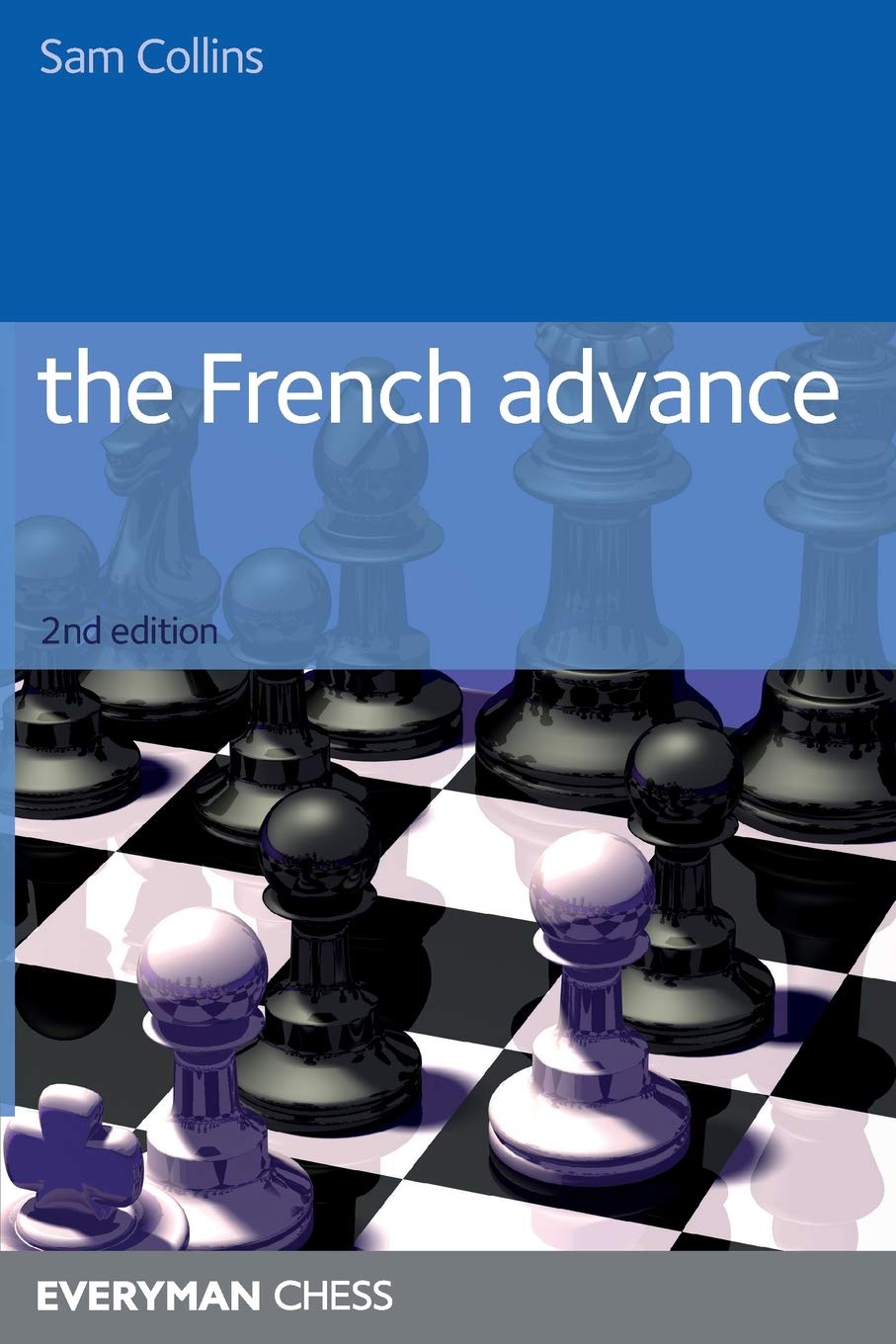
Recommended line(s)
Advance variation with 3. e5
Recommended level
Beginner, Intermediate, Advanced
Brief overview
Advancing the e5 and seizing space is a natural reaction to the advance of the black d-pawn. And indeed, the Advance variation is very common among beginners and club level players. Even some top players (Sveshnikov, Grischuk) play it regularly, with good results.
The French Advance by IM Sam Collins focuses on this variation. Over the course of 9 chapters, it not only provides us with two possibilities against the mainline (6. a3 and 6. Be2), but also covers other setups by Black like 4…Qb6 and 5… Bd7. In other words, this book provides us with an overall repertoire against the French, based on 3. e5.
The thing I liked a lot is the introductory chapter in which the author clearly and coherently explains the basic strategical concepts revolving around the French
How to Beat the French Defence: The Essential Guide to Tarrasch by Andreas Tzermiadanos
Tarrasch with 3. Nd2
Recommended level
Intermediate, Advanced, Expert
Brief overview
The Tarrasch variation with 3 Nd2 is considered to be a very flexible and “safe” way of dealing with the French Defence. In his book (with somewhat presumptuous title) How to Beat the French Defence: The Essential Guide to Tarrasch, Greek International Master Andreas Tzermiadanos devotes 320 pages to the in-depth analysis of this approach.
Now, I am first to advise caution when a book contains the phrase “How to Beat” in the title. Nevertheless, it would appear that this tome is the only comprehensive overview of the state of the Tarrasch Defence. 3 Tzermiadanos mainly focuses on the main-lines and “tested” lines, but he also includes some of his own opinions about handling specific variation (his recommended c4 move, for example, is very rare).
The reviews of the book are mainly positive. Even Jeremy Silman commended it in his blog. There are some people who claim they find the organization of the material somewhat confusing and some people who complained that the author overlooked best replies for Black in certain lines. But, as I argued in my introductory post, that is, unfortunately, unavoidable when it comes to opening books.
All in all, I think How to Beat the French Defence: The Essential Guide to Tarrasch can serve as a good reference when preparing this variation for your own games.
The Complete French Advance: The Most Uncompromising Way To Attack The French Defence by Evgeny Sveshnikov and Vladimir Sveshnikov
Advance variation with 3. e5
Recommended level
Intermediate, Advanced, Expert
Brief overview
When one says “French Advance”, the name that should immediately cross the mind of any self-respectable chess player is the name of famous grandmaster Evgeny Sveshnikov, who has played it for the majority of his life and who has been its greatest proponent. In the book The Complete French Advance: The Most Uncompromising Way To Attack The French Defence, co-authored with his son Vladimir, he takes a comprehensive look and presents us with his “life work”.
Through 6 chapters, Sveshnikov provides a complete overview of the French Advance – from its historical appearances to plans and ideas available to both sides and theoretical state of the variation (at the time the book was written). In contrast to The French Advance by Sam Collins which was more suitable to lower-rated players, Sveshnikov’s book dives much deeper and is more suitable to players who are already somewhat familiar with our game.
P.S. For a more comprehensive review, you might want to check this article by Davide Nastasio on Georgia Chess News
P.P.S. The book is also available on Forward Chess
Grandmaster Repertoire: 1 e4 vs The French, Caro-Kann and Philidor by Parimarjan Negi
Recommended line(s)
Main lines with 3. Nc3
Recommended level
Advanced, Expert
Brief overview
Parimarjan Negi is a former chess prodigy who became a grandmaster at the age of 13 years, 4 months and 20 days, making him the second-youngest grandmaster at a time (sixth youngest at the moment of writing because other prodigies surpassed his feat since).
Even though he later didn’t pursue the career of a chess professional afterwards, he did stay connected to the game. 4 In 2014, he released the first book of the multi-series devoted to the opening repertoire for White based on the move 1 e4. The book Grandmaster Repertoire: 1 e4 vs The French, Caro-Kann and Philidor offers weapons against the three openings from the title.
Against the French Defense, Negi provides us with a comprehensive repertoire based on the move 3 Nc3. Not only does he cover all three big main moves by Black (3… dxe4, 3… Nf6 and 3…. Bb4), but he also covers some rare alternatives (such as 3…a6 or 3… h6).
Negi’s lines are principled, sharp and concrete and backed up by computer analysis and top-level games. He never shies away from the fight and basically provides us with a GM-level repertoire.
Of course, that means that the book is huge, the analysis is often long and difficult and definitely not suitable for beginner or intermediate players. Also, it is questionable whether all the lines have stood the test of time.
Nevertheless, I think that every club level player will vastly benefit from familiarizing himself with some of the lines offered in this book. 5
P.S. The book is also available on Forward Chess
French Toast: How Harikrishna Fries 1… e6 by Pentala Harikrishna
Recommended line(s)
Main lines with 3. Nc3
Recommended level
Advanced, Expert
Brief overview
Previously on this list, we have seen a physical book that wasn’t intended to be written but merely published on Chessable. Those of you who already considered this controversial might want to stop reading at this point, because I have decided to take things even further and recommend a Chessable repertoire that didn’t become a physical book (yet) – Pentala Harikrishna’s Chessable repertoire titled French Toast: How Harikrishna Fries 1… e6. 6
Harikrishna is currently the 2nd highest rated Indian player (after Anand). Just like Negi, he is a former prodigy and was the youngest Indian grandmaster at a time when he became one (in 2000).
The similarity between the two doesn’t stop there because Harikrishna – just like Negi – chooses 3 Nc3 as the main weapon against the French defence in his repertoire. However, in contrast to Negi who recommends main-lines, Harikrishna follows his own approach and provides the student with some less prominent lines.
For example, his main recommendation against the Winawer (3…Bb4) is taking on d5 (4 exd5, instead of the sharp 4 e5). Against the Steinitz (3… Nf6), he recommends the line involving the early knight retreat to e2 (4 e5 Nfd7 5 Nce2!?), formerly used by Anand with great success.
I went through the entire repertoire once and I have to say – I was impressed by the depth and the quality of the analysis. This is a true 2700 level of analysis… which unfortunately means some lines are incredibly sharp and complicated. The book is definitely not suitable for beginners, 7 but I think the rest of us mortals will definitely learn a thing or two by going through it and checking the lines.
FRENCH DEFENCE FROM THE BLACK PERSPECTIVE
First Steps: The French Defence by Cyrus Lakdawala
The French Defence 8
Recommended level
Beginner, Intermediate
Brief overview
Cyrus Lakdawala is an International Master from the United States who has gained prominence as a highly prolific author, who has written more than 40 – mostly opening – books. First Steps: The French Defence is a beginner’s guide – Cyrus starts from the very first opening moves and explains the idea and philosophy behind the French Defence. Only then does he proceed to analyze different opening variations and provide the reader with a complete opening repertoire.
Now, whenever someone is a productive author as Lakdawala, some caution is required, simply because quantity and quality are usually negatively correlated. According to prominent chess historian Edward Winter, Lev Polugayevsky once wrote that:
‘Ninety per cent of all chess books you can open at page one and then immediately close again forever. Sometimes you see books that have been written in one month. I don’t like that. You should take at least two years for a book, or not do it at all.’ 9
Winter has also criticized Lakdawala himself on several occasions on his website chess history:
“ […] the vastly over-published Cyrus Lakdawala even quoted Wikipedia on matters of opinion […] “10
“ […] All too often, it seems, authors of the ‘move by move’ books (Everyman Chess) have been recruited for their availability rather than suitability – most notably, the unshakeably available Cyrus Lakdawala […]” 11
Even so, I think First Steps: The French Defence is a choice worth considering (especially if you are a total beginner), due to the following:
– as I skimmed through the available sample of, I liked the way the material was presented and the writing style.
– Other reviews of the book are also very positive 12 (most notably this one on the official website of the US Chess Federation by Vanessa West)
– I have been unable to find a better book dedicated to an absolute beginner. The only alternative I stumbled upon was Starting Out: The French, but I really disliked it on the basis of the available sample and the reviews were much more negative.
Winning With The French by Wolfgang Uhlmann
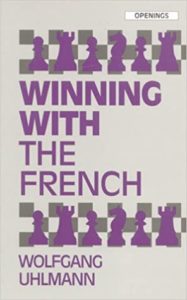 Recommended line(s)
Recommended line(s)
The French Defence 13
Recommended level
Beginner, Intermediate, Advanced
Brief overview
Wolfgang Uhlmann is a famous German grandmaster who belonged to the world’s strongest players in the middle of the 1960s. He is a well-known expert on the French defence who employed it almost exclusively as a reply to 1 e4 throughout his entire career.
His book titled Winning With The French 14 is not a classical reference opening book, but a game collection of Uhlmann’s French Defence games, annotated by the great master himself. I think there is a great value in having such a player explain the ideas and concepts behind Black moves, except maybe for higher rated players who are in need of concrete lines rather than general guidelines.
But everybody else will probably learn a thing or two about the French by going through this book.
The Even More Flexible French by Viktor Moskalenko
The French Defence 15
Recommended level
Intermediate, Advanced, Expert
Brief overview
In 2008, Ukrainian GM 16 Viktor Moskalenko published the book Flexible French, which was universally praised. 17 After writing yet another book on the French Defence in the meantime (The Wonderful Winawer in 2010), in 2015 Moskalenko decided to update his first book and The Even More Flexible French was born.
The book is curious in a sense that Moskalenko doesn’t just recommend singular lines, but offers several alternatives against White’s main tries. For example, the book has both Winawer (3… Bb4) and Steinitz (3… Nf6) chapters after White plays 3 Nc3 – something you would expect from an opening for White. And indeed – despite being an opening book for BLACK, Moskalenko analyzes several interesting options for White in the last part of the book.
The reasoning is that such an approach makes you flexible and less dependant on a concrete line, but rather on the understanding of the position. That is not to say that the book is not theoretical. Just that – in contrast to Berg’s trilogy which may be regarded as encyclopaedic – it is less of a reference book and more of a “let’s arm you for practical play” type of book.
P.S. You might also want to read John Donaldson’s review on Jeremy Silman’s website and Dennis Monokroussos’s review on his website thechessmind
P.P.S. The book is also available on Forward Chess
Grandmaster Repertoire: The French Defence by Emanuel Berg
The French Defence 18
Recommended level
Advanced, Expert
Brief overview
As I have mentioned previously, Negi’s book on 1 e4 repertoire was challenging, demanding and thick. It would appear it is no coincidence for a book from the Grandmaster Repertoire series, as the book by Swedish Grandmaster Emanuel Berg Grandmaster Repertoire: The French Defence follow suit.
The book offers a comprehensive, in-depth French Defence repertoire for the Black player. It is divided in three volumes, each devotes to a particular variation/set of variations, as follows:
- Volume I – Winawer (3 Nc3 Bb4) – everything apart from the most critical mainline with 7 Qg4
- Volume II – Winawer (3 Nc3 Bb4) – the most critical mainline with 7 Qg4
- Volume III – everything else, with the main focus on the Tarrasch (3 Nd2 ) against which Berg recommends 3 …. Nf6
Berg’s trilogy is certainly the most theoretical and encyclopedic series about the French Defence that will provide you with everything you need to fight against the French Defence.
However, the question is whether an average club player needs a book of this size (especially since three volumes means it costs more). Such a thick volume is more likely to suffer from problems mentioned in the introductory article of opening book series – namely, analysis of variations that are extremely unlikely to be met over the board.
Even though I am a huge theory nerd, in recent years I have noticed I have started preferring more practical opening books. Nevertheless, some people prefer to have a huge reference book which they can use both to learn critical lines by heart and to consult it when they encounter a less familiar variation (something that is not guaranteed by The Flexible French).
As usual life, it is a matter of preference. If money and time are not huge obstacles, you probably won’t go wrong with Berg’s book. If they are, you might do better to choose something else.
P.S. The books are also available on Forward Chess:
Playing the French (Grandmaster Guide) by Jacob Aagard and Nikolaos Ntirlis
The French Defence 19
Recommended level
Advanced, Expert
Brief overview
It would appear that Black players wishing to employ the French Defence are spoilt for choice nowadays. Even though I have already included two thick and demanding books, about the French Defence on this list, I simply couldn’t bring myself not to mention yet another tome, written by famous chess trainer Jacob Aagard, in collaboration with chess expert Nikolaos Ntirlis.
Over 288 pages, the authors provide a comprehensive French Defence repertoire for the Black player. Their recommendations are the Steinitz (3… Nf6) against 3 Nc3 and the principled 3… c5 against the Tarrasch (3 Nd2). The authors also analyze the Advance Variation, the annoying exchange variation, the King’s Indian Attack and even the rare Wing Gambit.
It seems to me that this book lies somewhere between Berg’s book and Moskalenko’s book – it is not as thick and theroetical as Grandmaster Repertoire: The French Defence, but it is a tad more systematic and straightforward than The Flexible French. I’d say that a serious French Defence player won’t go wrong by getting any of them (or even all of them) 20
Ultimately, it is a matter of taste.
P.S. You might also want to check the review on Jeremy Silman’s website
P.P.S. The book is also available on Forward Chess
- In chess24 streams, even Peter Svidler has lamented he doesn’t understand it at all.
- If you are not familiar with the concept of Chessable, I refer you to my post where I review it
- At least when it was written. Or when this blog post was written.
- As they say – you can take a chess player away from chess, but you can’t take chess away from a chess player
- Especially since the state of theory on the club level changes much slower than on the top level, which means that once you learn complicated and sharp lines, you will be more likely to use them for a longer period of time
- In general, I think that Chessable repertoires are basically digital opening books, although I imagine some people might disagree
- On my Chessable review post, I got a comment that entire Chessable is not suitable for <1000 rated players, which probably has some merit
- I know, I know, quite unexpected.
- Source – Edward Winter: Historical Havoc
- Source – Edward Winter: Chessnote 9511: According to Wikipedia
- Source – Edward Winter: Chessnote 10341 Reti
- Even though I once again have to agree with Winter who said that it is easy to be a chess book reviewer, it is difficult to be a good book reviewer
- Yes, I am really going to repeat this in every book from the Black perspective.
- Another iteration of “Beating the XYZ” often featured when it comes to opening books
- Yup, it is still here.
- Who is nowadays residing in Spain
- For example, in this review by Jeremy Silman
- Sorry about that, but my OCD doesn’t allow me to simply delete it.
- Now, it would be stupid to remove the “Recommended line” section in the LAST book on the list, wouldn’t it? :)
- As long as he keeps in mind that you ALWAYS need to do some analysis and work independently of chess books.





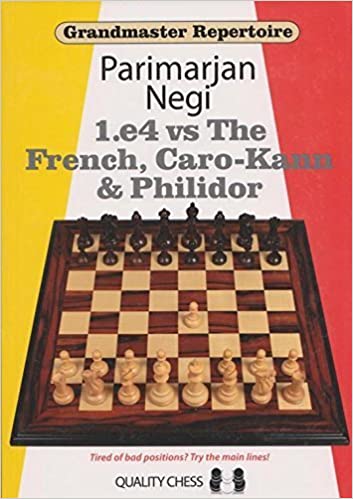

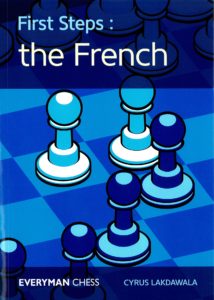


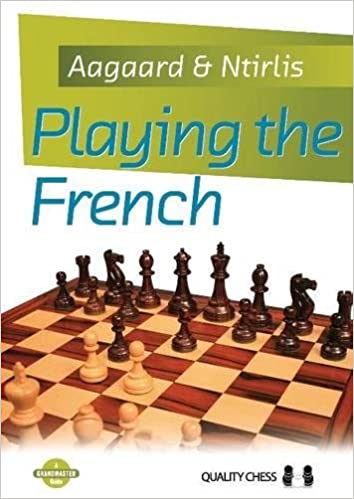
I’d be interested in hearing your thoughts about Neil McDonald’s “How to play against 1 e4” which is exclusively about the French.